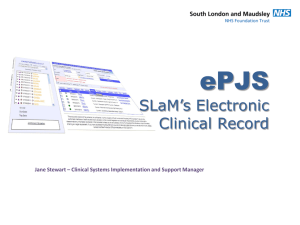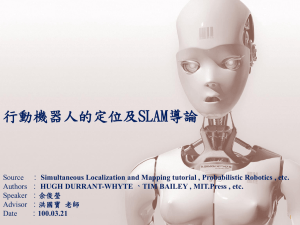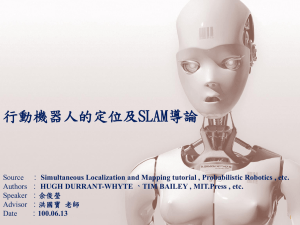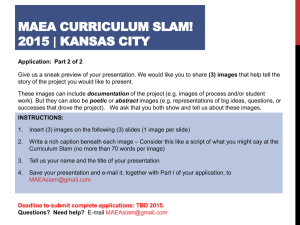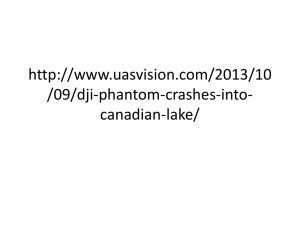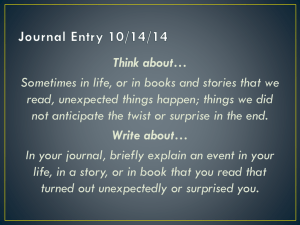Lecture 15 - with animation
advertisement
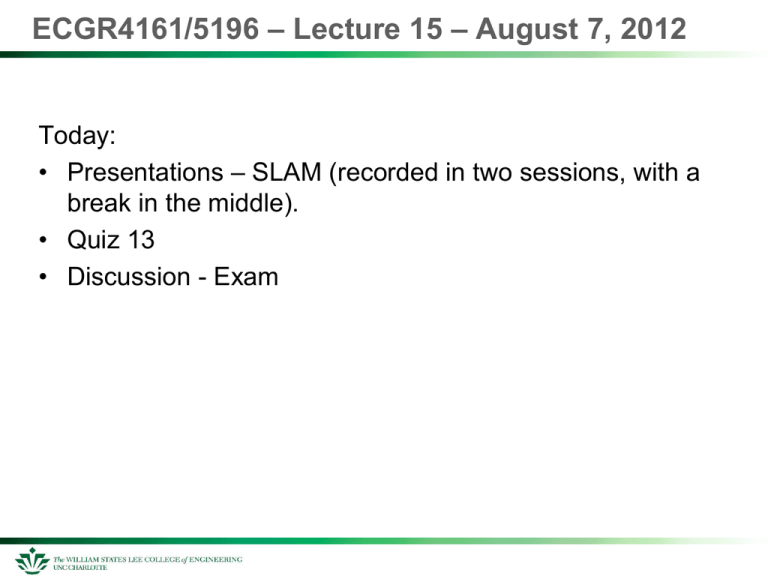
ECGR4161/5196 – Lecture 15 – August 7, 2012 Today: • Presentations – SLAM (recorded in two sessions, with a break in the middle). • Quiz 13 • Discussion - Exam Multi Robot SLAM and Map Merging Need for Map Merging Scan Matching SLAM The main aim is to find the most likely global map. Define map m based on the laser scan, pose and time. Take various laser measurements and odometry readings for different time slots. Reference http://tv.uvigo.es/uploads/material/Video/2662/P05.pdf 2 SLAM with RFID Technology • Technique: • • • • Laser range scanner and two RFID antennas. Uses “map previously learned from laser range data.” Estimate location of RFID tags. Apply Monte Carlo localization to estimate location • Benefits: • Reduces time required for localization of robot. • Accurately localize moving objects. • Low cost to implement. [1] Dirk Hahnel, Wolfram Burgard, Dieter Fox, Ken Fishkin, Matthai Philipose. “Mapping and Localization with RFID Technology.” Intel Research. December 2003. <http://edge.rit.edu/content/P12015/public/Referenca%20Materials/RFID%20READER%20SKYTEK%20M9%20Module/Mapping%20and%20Localization%20with %20RFIDs.pdf> 3 RHINO High-Speed Mapping and Navigation Mapping Localization Navigation Grid-Based Maps Wheel Encoders Map Matching Sonar Modeling Maneuverability Wall Orientation Landmarks •Global Planner •Collision Avoidance •Hard Constraints •Soft Constraints •Ultrasonic Sonar •Stereo Camera •Integration Topological Maps Figure 2: Example of Topological Mapping (a) (b) Figure 1: Bird’s Eye View of (a) Ultrasonic Sensor and (b) Occupancy Mapping Figure 3: Example of Navigation Reference 1. Thrun, Sebastian, et al. "Map Learning and High-Speed Navigation in RHINO." http://www-home.fhkonstanz.de/~bittel/robo/thrun_MapLearningAndNavigationInRhino.pdf (accessed July 7, 2012). 4 Stanley – Stanford University DARPA Challenge • Probabilistic Terrain Analysis Algorithm (Enabled High Speed Desert Driving). • 5 LIDAR Units used for 3D Mapping. • Inertial guidance system (3 gyroscopes and 3 accelerometers). • GPS Waypoints. • Color Video Camera. • Output data from the 3D LIDAR was compressed into a 2D map divided into a grid of 30 x 30 cm cells. • Cells are then designated as either: drivable, obstacle, or unknown. • Software algorithm compares samples of video deemed to be “drivable” by the LIDAR map and uses this “knowledge” to determine the “drivable surface in the remainder of the video. 5 A Lightweight SLAM Algorithm for Indoor Environment Assumptions: Orthogonality Most indoor major structures can be represented by sets of parallel or perpendicular lines or planes. Only map planes verifying the Orthogonality constraint. Removes estimation of the robot’s 3D orientation Reduces mapping of the orthogonal planes to a linear estimation with one parameter per plane Divides planes into three groups: X-Planes, Y-Planes and ZPlanes Within a group, the orientation of the planes is known. Only need to estimate the distance from the origin to the plane. Pros: Simple, fast and reduced processing power Cons: Orthogonality assumption, does not work well in outdoor environment or with complex surfaces Reference: A Lightweight SLAM Algorithm using Orthogonal Planes for Indoor Mobile Robotics, Nguyen, V; Harati, A; Siegwart, R. Autonomous Systems Laboratory. Swiss Federal Institute of Technology 6 Slam – Rapid 3D Mapping SLAM is the problem of building a map of an unknown environment while at the same time navigating the environment, using the unfinished map 3D maps give you an overhead view of a location, like a traditional paper map. 3D maps give you a schematic, angled view of the route ahead of you, as if seen from the air above you. http://www.saabgroup.com/Global/Documents%20and%20Images/Campai gns/Rapid%203D%20Mapping/Hoover_Dam_Rapid_3D_Mapping_small.j pg 3 Steps to Superior Awareness 1. 2. 3. Fly Generate View 3D Mapping Applications Videos http://www.youtube.com/watch?v=s6odzWGqi70&feature=player_embedded http://www.youtube.com/watch?v=CNemPTHOKWg&feature=player_embedded http://www.saabgroup.com/Global/Documents%20and%20Images/Campaigns/Rapid% 203D%20Mapping/SanFransisco_small.jpg IMU and Lidar J. Scot Collins 1. IMU – Inertial Measurement Unit – 3 Gyroscopes • Measures the rotation around/about an axis.(Pitch, Roll, Yaw) – – The rate of change of the angle. 3 Accelerometers • Measure the acceleration indirectly through a force that is applied to one of its walls/springs. Videos: 2. http://youtu.be/cquvA_IpEsA - gyro http://youtu.be/sieBqVxTz2c - IMU/LIDAR LIDAR – Light Detecting and Ranging • Emits laser light and detects the light reflected back by objects. Based on the time to return distance can be determined. • Can scan up to 360 degrees continuously. References: Livesay, Ed. “Accelerometer spring model.” Drawing. The Traffic Accident Reconstruction Origin 6 Aug. 2012. <http://tarorigin.com.> Kieff. From Wikimedia Commons. <http://en.wikipedia.org/wiki/File:Gyroscope_precession.gif.>http://absoluteastronomy.com Tandy, Michael. From Wikimedia Commons.<http://upload.wikimedia.org/wikipedia/commons/c/c0/LIDAR-scannedSICK-LMS-animation.gif.> Gadget Gangster. “Accelerometer & Gyro Tutorial.” Instructables. 6 Aug. 2012. <http://www.instructables.com.> 8 iRSP SLAM 3D Execution This PowerPoint is about the demonstration of 3D SLAM capability of a robot using iRSP(intelligent Robot Software Platform). The map data for the demonstration is updated from the calculated position of the robot using simulated onboard range sensors. Simulated robot: • Motor: 2 DC Motors • Sensors: • 1D range sensor: 8 Sonar sensors • 3D range sensor: Xtion-Pro • Direction sensor: Absolute Compass Sensor Video: http://www.youtube.com/watch?v=AByETaadky4 9 Intelligent Technologies for SLAM • • • • • Spiking neural network human localization Mapping in unknown locations Neural gas Evidence supporting measure of similarity Unified fusion approach http://www.sciencedirect.com/science/article/pii/S002002551000530X 10 Atlas – mapping of large-scale environments Algorithm: Dijkstra Shortest Path • Starts at a source vertex • Creates a tree to other vertices • Ordered by distance Results: • 101 map-frames • 15 mapped line segments Method of Storage: • Local Region SLAM • Map-frame hypotheses • Juvenile • Mature • Dominant • Retired Visualization: • Global Optimized Map • Atlas graph Bosse, Newman, Leonard, et al. International Conference on Robotics and Automation, TBipei, Taiwan, September 2003, pp. 1899-1906 11 MITRE -Improving design on UGA’s and UAV’s -Now 2D Frames of video -Moving to 3D Virtual Mapping on the move -For use in Military situations -city streets -building interiors -Uses stereo vision and flash LIDAR http://www.mitre.org/news/digest/advanced_research/06_08/a_situation.html 12 Mars Rover – SUMMITT/Waypoint and Frames System for Unifying Multi-resolution Models and Integrating Three-dimensional Terrains • Utilizes 3 sets of fixed cameras with each in stereo • Each camera produces a disparity map that identifies matching features in each image • Computes the range to a pixel in one image to its matching pixel in the other image • Used to create XYZ point cloud model[2] • IMU and motor encoder • Rover Motion Counter for vehicle moves • RMC resets when a site SUMMITT Flow Diagram [1] frame is made • Site frame created when the total localization error is at a point that targeting accuracy suffers • Many site frames can be combined in order to form a comprehensive operational map[3] MER [2] [1]http://wwwdial.jpl.nasa.gov/public_html/john/papers/SMC_Hawaii/SMCpaper.pdf [2]http://marsrover.nasa.gov/mission/spacecraft_surface_rover.html [3]http://wwwrobotics.jpl.nasa.gov/publications/Mark_Powell/IEEE_IRI_06_Targeting.pdf 13 Online SLAM in Dynamic Environments •Uses Kalman Filter to estimate robot position and landmarks •Uses 3 occupancy grids static, dynamic, and location •Static map is created first then dynamic •Dynamic objects must move at least once •Third map used for location of landmarks for localization Static Map Dynamic Map Source:http://cres.usc.edu/pubdb_html/files_upload/378.pdf Combined Map 14 Occupancy Grid Mapping (OGM) •Occupancy grids were first popularized by Hans Moravec and Alberto Elfes at CMU, Pittsburgh, PA. •Maps the environment in a 2D array. •The Robot knows its location at all times. •Each cell holds a probability value that the cell is occupied. http://www.ikaros-project.org/articles/2008/gridmaps/ Map-Making Robots • Bayes Law: p(A | B) = p(B | A) * p(A) p(B) •Typical sensors: Sonar, Laser, IR, Bump, etc. http://www.ikaros-project.org/articles/2008/gridmaps/ E-puck robot (www.e-puck.org) 15 [3] R.O.A.M.S. R.O.A.M.S. is an acronym for Remotely Operated and Autonomous Mapping System • ROAMS uses a unique 3-axis rotary actuator to enable the LIDAR to be used both as 2D (Obstacle avoidance) and 3D (Mapping) • Students at Stevens have developed their own software based Operator Control Unit (OCU) so anyone from any network connected PC can control the ROAMS robot ROAMS is only capable of acquiring 3D LIDAR scans while it is stationary [1] • Multiple Path Planning sensors are used such as IR, GPS, and real time video Video registration is used for texturing of scan points to provide photo realistic 3D maps What will this mean for the Future?... [2] [4] [5] Enter the Matrix… References: [1] (2011). Remotely Operated and Autonomous Mapping System (ROAMS) (2011). [Web Photo]. Retrieved from http://www.ballos.com/tepraconnect_interface/TePRA09/335.pdf/ [2] (2012). Remotely Operated Autonomous Mapping System: (2012). [Web Photo]. Retrieved from http://www.dmi.stevens-tech.edu/index.php / [3] (2012). Stevens (Stevens IOT LOGO)(2012). [Web Photo]. Retrieved from http://www.stevens.edu/sit/ [4] (2011). The World OF Matrix (2011). [Web Photo]. Retrieved from http://blogs.cornell.edu/newmedia11jz387/2011/04/13/the-world-of-matrix/ [5] (2011) Reflection intensity panorama produced by ROAMS scanner. In complete darkness.(2011). [Web Photo]. Retrieved from http://www.dmi.stevens-tech.edu/index.php • Ergonomically designed to fit into most commercial office/building spaces • Reflection intensity panorama produced by ROAMS scanner. In complete darkness. Presented by: Benjamin B. Rhoades Date presented: 8-7-2012 16 SLAM using DIDSON-Acoustic Imaging Sonar Figure 1: 3D Ocean Floor Mapping [2] Applications: ship hull and infrastructure inspection, marine structure inspection, under water survey and navigational based mapping Sensors: •DVL (Doppler Velocity Log) – navigation “underwater GPS”, under water current tracking • Depth Sensor • DIDSON 1.8MHz (Dual frequency Identification Sonar) – uses sound waves to map and create an image of the ocean floor or the hull of a ship Figure 2: HAUV with DIDSON [1] Procedure: • SLAM uses the data and statistics acquired from the on board sensors and DIDSON • Sensors and DIDSON combine to create 2D and 3D maps of unknown objects/environments • Improves accuracy of existing maps by localization and not relying on external infrastructure Works Cited: [1] Publication: “SLAM for Ship Hull Inspection using ESEIF” Massachusetts Institute of Technology, Walter, M.; Franz, H.; Leonard, J. (pages 1-8). http://people.csail.mit.edu/mwalter/papers/walter08a.pdf [2] http://www.oceanmarineinc.com/sonar-systems/didsonsoftware_P1019 Real-Time Stereo Visual SLAM -What is simultaneous localization and mapping? -Most common sensors used for SLAM: -Laser ranging -Sonar -Inertial -Vision Why are vision based sensors superior in a SLAM application? Why stereo visual slam? Processing stereo SLAM: -images are captured using two cameras -converted to gray scale -scale spaces are created -correspondences are estimated using camera projection matrixes -based off of initial calibration of cameras P. Elinas, J. Little, R. , " Stereo vision SLAM: Near real-time learning of 3D point-landmark and 2D occupancy-grid maps using particle filters.," University of British Columbia S. Thomas, "Real-time Stereo Visual SLAM," Heriot-Watt University 18 Mini-SLAM Hardware uses odometry and an omnidirectional camera. The camera supplies information used by SLAM algorithm. Map estimations done by a linear time SLAM algorithm using graph representation. More consistent maps created. Scales better due to not estimating landmark locations Instead, object similarity used to determine landmark locations. Uses Multilevel Relaxation algorithm to determine that objects in images are the same. “Mini-SLAM: Minimalistic Visual SLAM in Large-Scale Environments Based on a New Interpretation of Image Similarity.” Henric Andreasson, Tom Duckett, and Achim Lilienthal. <http://aass.oru.se/~han/papers/icra07andreasson.pdf>. 19 Particle Filter Based SLAM • 2 reference frames • Robots •Sensor ex: Odometer • World •Sensor ex: laser rangefinder Example Algorithm Psuedo Code For Each line in logfile If logfile line = odometer entry -predict particle If logfile line = laser rangefinder For Each particle in particle set -Extract corners & decide if new if corner has been seen previously compute new weight of corner else add new corner to particles Top: Course Bottom: Particle filter calculations[1] [1] Luciano, S. Xavier. P. Exercise 4: Particle Filter Based Slam, 2008, Autonomous Systems Lab Swiss Federal Institute of Technology, Zurich Jessica Meeks ECGR 4161 20 SLAM Robot: Laser Range Finder and Monocular Vision • • • • • Harbin Institute of Technology Autonomous Robot Weighted least square fitting Canny Operator Kalman filtering (KF): localization & grid map building simultaneously Experiment Robot: •CMOS camera and optic mica •Radio Ethernet Reference: SLAM for Mobile Robots Using Laser Range Finder an d Monocular Vision, Sheng, F.; Hui-ying, L.; Lu-fang, G.; Yu-xian, G.; 2007 IEEE 21
